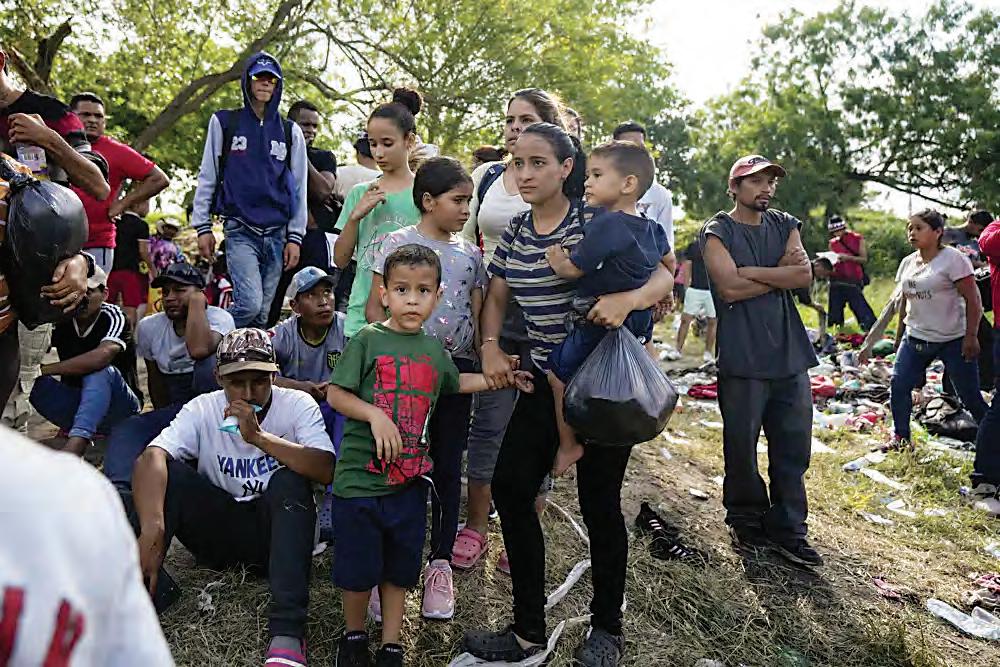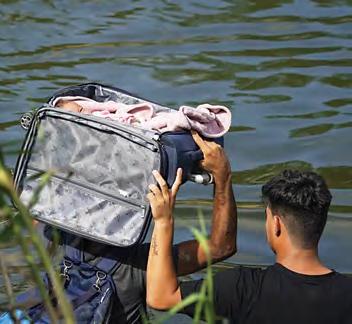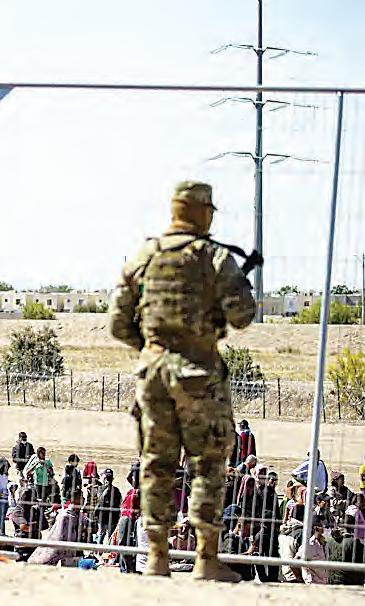
9 minute read
Grandes cifras de inmigrantes en frontera sur de EE.UU. ante el fin del Título 42; hay reglas nuevas
Huge Number of Asylum Seekers at U.S.-Mexico Border as COVID-19 Restrictions End, New Rules Begin
CIUDAD JUÁREZ, México (AP) --- El gobierno estadounidense empezó el jueves, 11 de mayo, a negar asilo a los inmigrantes que llegaban a la frontera sur del país y no habían presentado primero una solicitud por internet o buscado primero protección en uno de los países por los que pasaron, lo que representa un cambio fundamental en la política migratoria de Estados Unidos tras el fin a las restricciones implementadas durante la pandemia.
Advertisement
Los solicitantes de asilo se habían estado presentando en grandes números en la frontera en anticipación al fin del uso de las restricciones del llamado Título 42, las cuales facultaban al gobierno para expulsar rápidamente a los inmigrantes. Funcionarios federales advirtieron que se avecinan días complicados, ya que el programa vinculado con la pandemia del COVID-19 expiraba esta semana.
La nueva regla anunciada el miércoles, 10 de mayo, forma parte de nuevas medidas que tienen el objetivo de reducir los cruces fronterizos ilegales al tiempo que crean nuevas vías legales, como un plan para abrir 100 centros de inmigración regionales en todo el hemisferio occidental y otorgar permisos condicionales humanitarios a unos 30.000 inmigrantes procedentes de cuatro países para que ingresen a Estados Unidos. Funcionarios federales detallaron las medidas que se han adoptado, como el incremento en el número de vuelos de deportación, mientras se preparaban para lo que muchos esperan que sea un aumento sustancial de inmigrantes en la frontera sur de Estados Unidos.
“Nuestro plan dará resultados, pero tomará tiempo para que esos resultados se reflejen”, advirtió el secretario de Seguridad Nacional, Alejandro Mayorkas.
Muchos inmigrantes, impulsados por el temor de que fuera más difícil permanecer en Estados Unidos después, intentaban cruzar antes de que expirara el Título 42 y entrara en vigor la nueva norma al final del día jueves.
Bajo el amparo del Título 42, las autoridades fronterizas han enviado de regreso rápidamente a los inmigrantes: lo hicieron 2,8 millones de veces desde marzo del 2020. Pero después de que las restricciones expirasen el jueves, los inmigrantes que sean detenidos cruzando ilegalmente la frontera tendrán prohibido regresar durante cinco años. Pueden enfrentar cargos penales si lo hacen.
Los inmigrantes llegaban constantemente el miércoles al río Bravo (o Grande), en Matamoros. Muchos se quitaban la ropa antes de entrar al río, aferrándose a bolsas de plástico en las que llevaban sus pertenencias. Vadeaban lentamente el río mientras llegaban más inmigrantes, algunos de ellos persignándose antes de seguir la fila a través de la frontera. Una familia puso a un bebé dentro de una maleta abierta. Un hombre la sostuvo por encima de su cabeza mientras que otro caminaba lentamente detrás de él como precaución. Otro niño cruzó sobre los hombros de un adulto. Del lado estadounidense, lograron subir la orilla, tomándose un momento para colocarse ropa seca antes de seguir su camino entre las hileras de alambre de púas.

En Ciudad Juárez, México, los inmigrantes siguieron llegando esta semana en pequeños grupos por tren o autobús, y partían a diario para entregarse a las autoridades estadounidenses.
Fran Tovar, un electricista de 30 años de edad procedente de Venezuela y que dejó atrás a sus dos hijos para tratar de llegar a Estados Unidos, fue expulsado en su primer intento. Dijo que trataría nuevamente en 24 horas, con el objetivo de cruzar antes de que expirara el uso del Título 42.
“Hay temor y angustia”, dijo Tovar, quien añadió que llevaba más de tres meses en Juárez tratando de obtener una cita a través de una aplicación que Estados Unidos ha pedido a los inmigrantes que utilicen para presentarse en un punto de entrada fronterizo y solicitar la admisión.
La Patrulla Fronteriza detuvo a cerca de 10.000 personas el martes, 9 de mayo, una de las cifras más altas para un solo día, según un funcionario federal que habló con The Associated Press bajo condición de anonimato debido a que no estaba autorizado a tocar el tema de manera pública.
Más de 27.000 personas se encontraban en custodia. La cifra de personas en custodia varía a medida que los inmigrantes son liberados o deportados, pero en marzo ha- bía 8.600 personas bajo la custodia de la Patrulla Fronteriza.
Miguel Meza, director de programas migratorios para Catholic Relief Services, el cual cuenta con 26 albergues para inmigrantes en todo México, calculó que el miércoles, 10 de mayo, había alrededor de 55.000 inmigrantes en ciudades aledañas a la frontera con Estados Unidos. El espacio de albergues está “saturado”, señaló, y los inmigrantes se estaban extendiendo a zonas circunvecinas.
La medida anunciada el miércoles es una parte clave de la estrategia de Estados Unidos para acotar los cruces fronterizos que alcanzaron máximos históricos incluso con el Título 42 en vigor. Sin llegar a ser una prohibición total, la medida impone fuertes limitaciones al asilo para aquellos que crucen de manera ilegal y que no hayan buscado antes un acceso legal. También tiene un margen para excepciones y no se aplica a los niños que viajan sin compañía de un adulto. Se anunció por primera vez en febrero.
Un tribunal federal de apelaciones evitó que entraran en vigor medidas similares, pero más estrictas, que buscaba imponer el entonces presidente Donald Trump en el 2019.
Grupos defensores de los derechos humanos señalaron que planean presentar una demanda.
“Esta medida causará un grave daño a las personas”, dijo la abogada de la Unión Americana de Libertades Civiles (ACLU, por sus iniciales en inglés), Katrina Eiland.
Señaló que, como resultado de ésta, los inmigrantes quedarían varados en el norte de México. Dijo que la regla se basaba en la idea de que los inmigrantes podían recibir protección en otro país u obtener una cita por internet para solicitar asilo en Estados Unidos. Aseguró que existen serios problemas con esas dos opciones.
Funcionarios estadounidenses también dijeron que planeaban abrir centros regionales por todo el hemisferio, donde los inmigrantes puedan solicitar ir a Estados Unidos, Canadá o España. Se habían anunciado previamente dos centros en Guatemala y Colombia. De momento no está claro dónde se abrirían otros. Los funcionarios del gobierno estadounidense hablaron bajo condición de anonimato para discutir planes fronterizos que no han sido dados a conocer.
La mayoría de las personas que se dirigen a la frontera entre Estados Unidos y México huyen de la persecución o la pobreza en sus países de origen. Los inmigrantes y los grupos que trabajan con ellos señalaron el torbellino de rumores y desinformación de los traficantes que dificulta que los inmigrantes sepan qué hacer.
En Matamoros, Carmen Josefina Characo López dijo que llegó hace más de un mes y que había estado tratando de usar la aplicación del gobierno de Estados Unidos para programar una cita para solicitar
Continued on page 4
Vivian Fernández-de-Adamson Editora | Editor
Rafael Figueroa Coordinador de Medios Digitales Digital Media Coordinator
Pedro Acevedo Editor Asociado |Associate Editor
Miguel A. Cardozo Mercadeo | Marketing
Karla Lobo Social Media
Donna Donald Brad Boutwell Diseño Gráfico | Design
Dawn Ellis Administración | Administration
Jairo Arguijo Director de Operaciones |Operations Director
Sidney Mendelson Director
BETTER BUSINESS BUREAU From page 3 asilo.
“Las que van llegando van escuchando los cuentos de los otros, y se van alarmando. ’Oye, ¿tú tienes cuatro meses? No, yo llegué. Yo voy a cruzar o tratar de cruzar. Y ese es el dilema”, comentó.
ENGLISH:
CIUDAD JUAREZ, Mexico (AP) --- The Biden administration on Thursday, May 11, began denying asylum to immigrants who arrived at the U.S.-Mexico border without first applying online or seeking protection in a country they passed through. It marks a fundamental shift in immigration policy as the U.S. was getting ready for the end of a key pandemic restriction.
Asylum seekers had been showing up at the border in huge numbers in anticipation of this week’s end of the use of a restriction known as Title 42. That rule allowed the government to quickly expel immigrants to Mexico. U.S. officials warned of difficult days ahead as the program tied to the COVID-19 pandemic was expiring this week.
The rule announced on Wednesday, May 10, is part of new measures meant to crack down on illegal border crossings while creating new legal pathways. Families who cross the border will face curfews and monitoring; the head of household will wear an ankle bracelet as their cases are heard within 30 days.
But there’s also a plan to open 100 regional migration hubs across the Western Hemisphere and granting humanitarian parole to 30,000 people a month to enter the country from four countries. U.S. officials have detailed steps they’ve taken, including increasing deportation flights, as they prepare for what many are expecting to be a substantial increase in immigrants at the U.S.-Mexico border.
“Our plan will deliver results, but it will take time for those results to be fully realized,” Homeland Security Secretary Alejandro Mayorkas warned.
Many immigrants, spurred by concerns that it could soon be harder to stay in the U.S., tried to cross the border before the end of Title 42 and the new rule took effect at the end of the day Thursday.
Under Title 42, border officials have quickly returned people — and they did so 2.8 million times since March 2020. But after the restrictions that expired on Thursday, those immigrants that get caught crossing illegally will not be allowed to return for five years. They can face criminal prosecution if they do.
At the Rio Grande in Matamoros on Wednesday, immigrants arrived steadily. Many stripped down before descending the steep riverbank grasping plastic bags filled with clothes. They slowly waded into the river as more immigrants arrived, some crossing themselves before following the line across the flowing border. One family swaddled a tiny baby inside an open suitcase. A man held it atop his head while another waded beside him as a precaution. Other children rode on shoulders. On the U.S. side they scrambled up the bank, pausing to put on dry clothing, before carefully picking their way through the rows of concertina wire.
In Ciudad Juarez, immigrants arrived this week in small groups by train or bus, leaving daily to surrender to the U.S. authorities.
Fran Tovar, a 30-year-old electrician from Venezuela who left two children behind to try to reach the U.S., was expelled from the U.S. on his first attempt. He said he was going to try again 24 hours later, with the goal of crossing before the expiration of Title 42.
8,600 people were in Border Patrol custody.
Miguel Meza, the head of immigrant programs for Catholic Relief Services, which has 26 immigrant shelters across Mexico, estimated that about 55,000 immigrants were in the border cities across from the U.S. on Wednesday. The shelter space is “saturated,” he said, and immigrants were spilling into areas around them.
The measure announced on Wednesday is a key part of the U.S. strategy to address border crossings that rose to all-time highs even with Title 42 in effect. While stopping short of a total ban, it imposes severe limitations on asylum for those crossing illegally who didn’t first seek a legal pathway. It includes room for exceptions and does not apply to children traveling alone. It was first announced in February.
A federal appeals court prevented similar but stricter measures pursued by then-President Donald Trump in 2019 from taking effect.
Human rights groups said they plan to sue quickly.
“This rule will subject people to grave harm,” said American Civil Liberties Union lawyer Katrina Eiland.
She said it would result in immigrants stranded in northern Mexico. She said the rule was predicated on the idea immigrants can get protection in another country or get an appointment online to seek asylum in the U.S. She said there are serious problems with both those options.
U.S. officials also said they planned to open regional hubs around the hemisphere, where migrants could apply to go to the U.S., Canada or Spain. Two hubs were previously announced in Guatemala and Colombia. It’s unclear where the other locations would be. The administration officials spoke on the condition of anonymity to discuss ongoing border plans that were not yet public.
Most of the people going to the U.S.-Mexico border are fleeing persecution or poverty in their home countries. Immigrants and groups who work with them noted the swirl of rumors and disinformation from smugglers that makes it hard for migrants to understand what to do.
“There is fear and anguish,” Tovar said on Wednesday, adding that he had spent three months in Juarez trying to get an appointment through an app the U.S. has encouraged immigrants to use to present themselves at a border entry point and seek admission.
Roughly 10,000 people were apprehended by Border Patrol on Tuesday, May 9, among the largest apprehensions in a single day, according to a U.S. official who was not authorized to speak publicly and spoke to The Associated Press on condition of anonymity. More than 27,000 people were in custody. Custody numbers vary as immigrants are released or deported, but in March

In Matamoros, Carmen Josefina Characo Lopez said she arrived over a month ago and had been trying to use the U.S. government’s app to schedule an appointment to seek asylum.
“People who just arrive start hearing the stories of others who have been here longer, and they start getting alarmed. ‘Oh, you’ve been here for four months. Well, I just got here and I’m going to cross.’ And that’s where the dilemma is,” she said.










